Salvia - The Ultimate Growing Guide from Proven Winners®
Grow this easy-care flowering plant for long-lasting summer color
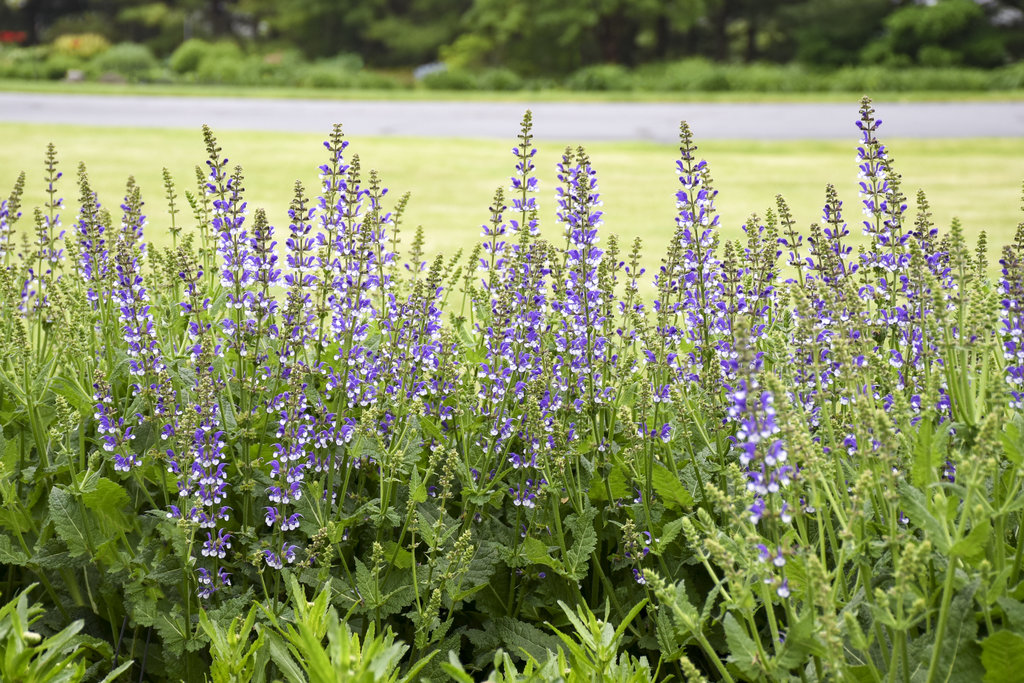 Buy salvia plants - Order online and have them shipped right to your door
Buy salvia plants - Order online and have them shipped right to your door
Salvia is a large genus of ornamental and culinary plants, with some 1,000 species worldwide. Plants produce aromatic foliage and attractive flower spikes in colors of purple, blue, red, pink, coral or white from late spring to fall, depending on the variety.
Native to hot, dry climates in the Mediterranean, Asia, Central and South America, garden salvias are heat and drought tolerant, deer resistant, and low maintenance. The tubular flowers, which have a long bloom time, are a favorite of beneficial insects, butterflies and hummingbirds.
PLANTING & SALVIA CARE
How to plant: Wait until all danger of frost has passed in your area. Choose a site with full sun to partial shade (at least 6 to 8 hours of direct sun) and well-drained soil. Follow these steps and space salvia plants 1 to 6 feet apart, depending on the variety.
- Loosen soil in the planting area and amend with organic matter to add nutrients and improve drainage.
- Dig a hole slightly wider and deeper than the root ball.
- Remove the plant from its nursery container and tease out roots if potbound.
- Set the plant in the hole with the top of the root ball level with the surrounding soil.
- Backfill the hole with soil, tamp down slightly to remove air pockets and water well.
- Water plants regularly until established.
Soil: Salvias can thrive in average soil, but good drainage is essential. Soil that is too rich may cause plants to become leggy and stems to fall over. When growing in pots, use a high quality all-purpose potting mix. Make sure containers have adequate drainage holes.
Watering: Drought tolerant once established, but performs best with consistent moisture. Allow soil to dry out between waterings and irrigate when the top 2 inches of soil becomes dry. Water more frequently during prolonged heat or dry spells. Plants in containers will need to be watered more often than those in the ground.
Fertilizing: Salvias are light feeders, requiring little supplemental fertilizer. Apply a balanced time-release fertilizer in spring or spread a thin layer of compost around the base of plants. Over-fertilizing can cause plants to become leggy and flop.
Pruning: Wait until spring to prune. For herbaceous perennials, remove dead stems back to the ground when new growth begins to emerge. For shrub types, remove dead, diseased or damaged branches, cut back the entire plant by a third to half of its size, and shape as needed.
TRY THESE PROVEN WINNERS® VARIETIES
Salvia plants come in a wide range of sizes, growth habits and flower colors. Try some of these varieties in your yard:
Annuals | |
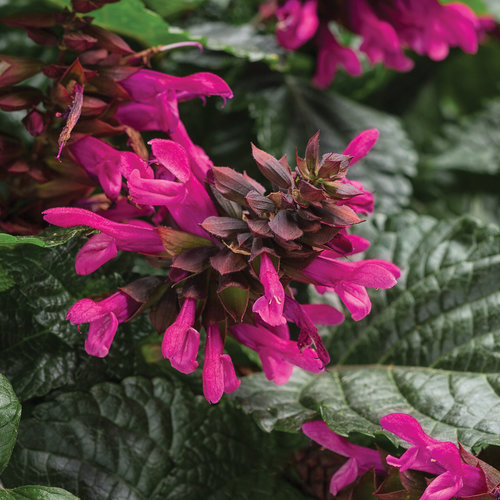 Rockin'® Fuchsia (Salvia hybrid) is a wonderful annual with vibrant flowers each with a black calyx on tough plants. It will just bloom, and bloom and bloom all season without stopping. Hummingbirds, butterflies and bees all love it, which makes it a great plant for pollinator gardens. Can be grown as a perennial in frost-free zones. Hardiness zones: 9-11 | 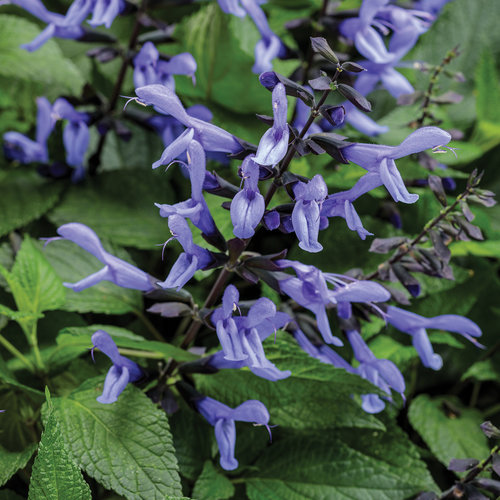 Rockin'® Blue Suede Shoes™ (Salvia hybrid) is a show-stopper with a vivid display of blue flowers. Easy to care for, drought-tolerant, and resistant to deer, it's a reliable and hassle-free addition to any garden or landscape. Hardiness zones: 9-11 |
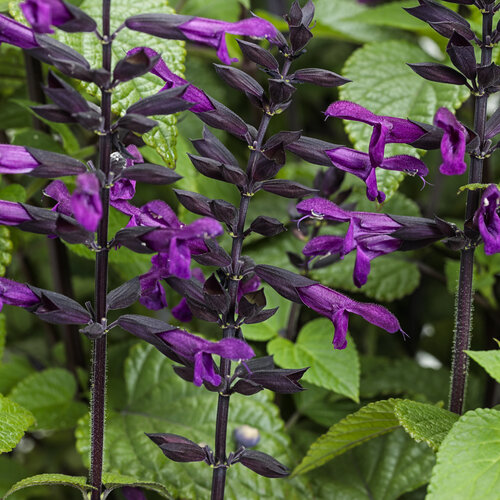 Rockin'® Deep Purple (Salvia hybrid) brings depth and drama to any garden or landscape. Its unique, deep purple blooms create a rich, velvety display from early summer right through to the first frost of fall. Hardiness zones: 9-11 | 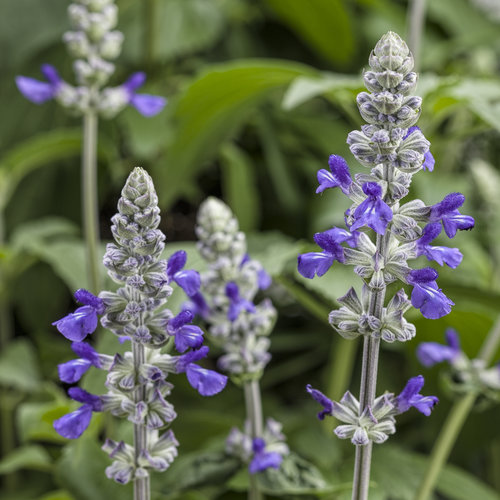 Rockin'® Playin' the Blues® (Salvia longispicata x farinacea) is a standout variety that charms with true-blue flowers above dark green foliage. Pollinators love it for its rich nectar, you'll love it because it's striking and low-maintenance. Hardiness zones: 7-10 |
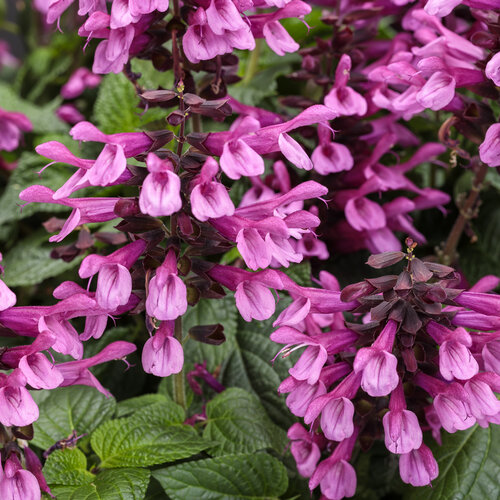 Unplugged® Pink (Salvia hybrid) is an annual that blooms from planting until frost. The tubular flowers are deep pink with a dark purple calyx, providing striking contrast in the landscape. Use this compact variety in containers, mass plantings or borders. Hardiness zones: 9-11 | 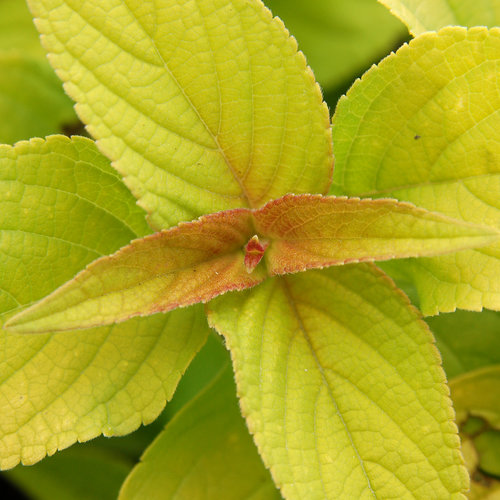 Proven Accents® ‘Golden Delicious’ Golden Leaved Pineapple Sage (Salvia elegans), which can reach up to 4 feet tall, is grown for the golden yellow pineapple-scented leaves. In warmer climates, bright red flowers appear in mid to late fall before the first hard frost. Use as a stand-alone accent, or as a background plant in a mixed border. Hardiness zones: 8-11 |
Perennials | |
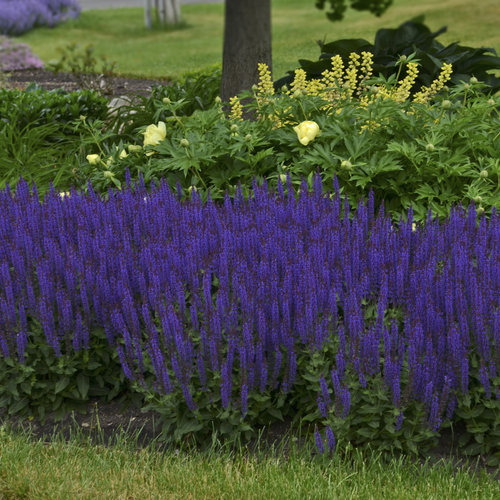 Color Spires® ‘Violet Riot’ (Salvia nemorosa) produces an abundance of vivid violet-blue flower spikes from late spring to early summer. This hardy salvia has a compact mounding habit suitable for mass plantings and as border edging. Hardiness zones: 3-8 | 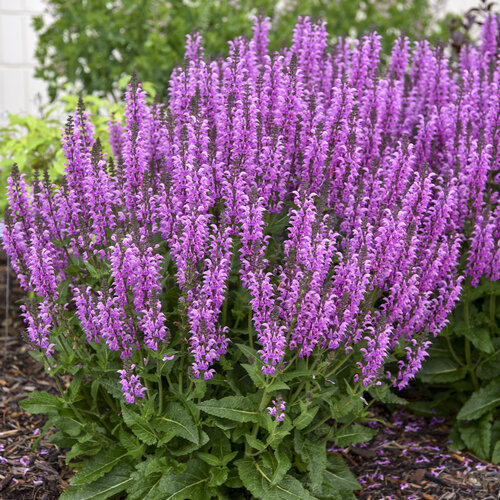 Color Spires® ‘Back to the Fuchsia’ (Salvia hybrid) is a hardy perennial with bright fuchsia pink flower spikes that bloom prolifically above the neatly mounded aromatic foliage. The compact habit is suitable for borders, mass plantings and containers. Hardiness zones: 3-8 |
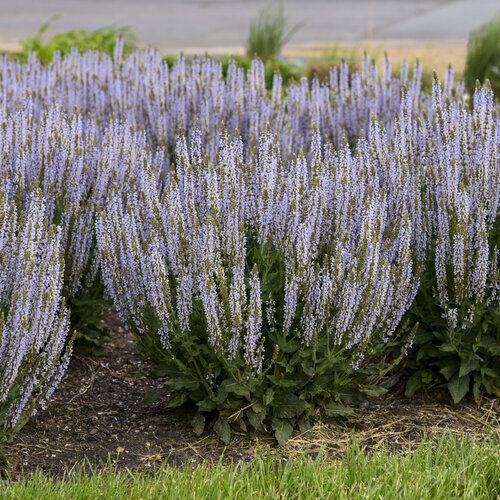 ‘Perfect Profusion’ (Salvia nemerosa) has soft icy blue flower spikes that begin blooming in late spring, with repeat bloom throughout the summer. Cut back spent flowers to promote rebloom. Use this hardy herbaceous perennial in mass plantings, containers and borders. Hardiness zones: 3-8 | 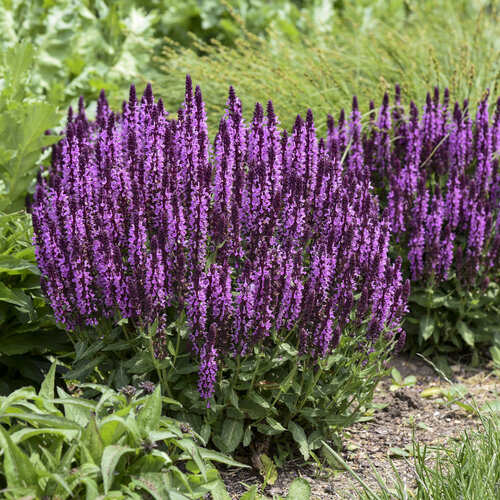 ‘Pink Profusion’ (Salvia nemerosa) is bursting with radiant dark pink blossoms. This plant is a summer spectacle that's resilient, easy-going, and thrives in almost any climate. To encourage its delightful reblooming habit, simply cut back the plant after flowering. Hardiness zones: 3-8 |
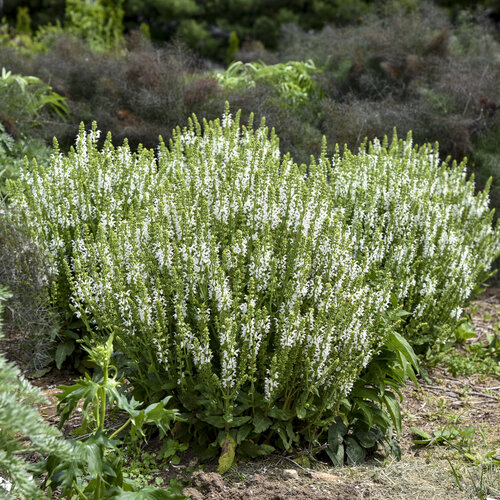 ‘White Profusion’ (Salvia nemerosa) is a hardy herbaceous perennial with snow-white flowers that appear in late spring, reblooming throughout the summer with regular deadheading. Densely compact plants are versatile in beds, borders and moon gardens. Hardiness zones: 3-8 |
Frequently Asked Questions
What is salvia?
Salvia is a flowering plant in the mint family, and is also related to rosemary and culinary sage. Different types of salvia include shrubs, herbaceous perennials, biennials or annuals.
Is salvia a perennial? Does it come back every year?
Some salvias are perennial in most zones, coming back from year to year. Others are tender perennials in warmer climates, or can be annuals or biennials.
Is salvia sage?
Ornamental salvia and culinary garden sage (Salvia officinalis) are in the same genus. Culinary sage flower color is pale lavender-blue. The terms “salvia” and “sage” are often used interchangeably.
Should I deadhead salvia?
Removing flowers after they have faded will promote rebloom. Using sharp pruning shears, cut flower stalks between the highest set of leaves and the lowest spent flower on the stem. Take care not to cut off adjacent side shoots, which will form the next set of flowers.
What to plant with salvias?
Salvias combine well with a wide range of shrubs, perennials and annuals. Site alongside other plants with similar growing needs of full sun and good drainage.
When to cut back salvias?
Wait until new growth emerges in spring to cut back or prune salvias.
When does salvia bloom?
Depending on the variety, they can bloom from late spring through fall. Some are repeat bloomers.
Where do salvias grow best?
Provide a site that gets at least 6 to 8 hours of direct sun and has well-draining soil.
Will my salvia survive the winter?
It depends on your climate and how hardy your salvia variety is. In colder regions, provide winter protection with mulch. To overwinter in containers, plant them in the ground in a sheltered spot by early fall. They tend to be slow to develop new growth in spring, so be patient.
Find more information on overwintering salvia.
HOW TO USE SALVIA IN YOUR LANDSCAPE
There are many ways to use salvia in your landscape. Here are some ideas:
- Plant along a fence line, alternating different colored varieties for a summer-long display.
- Use annual types as bedding plants alongside other annuals such as petunias, calibrachoa and lobelia for continuous color through warmer summer months. Find more easy-to-grow annual flowers.
- To create eye-catching contrast, plant blue or purple salvia alongside other summer-blooming flowers with complementary colors of yellow or orange such as coreopsis, marigold, helenium and gazania.
- For containers or window boxes, use an annual salvia variety such as Unplugged® Pink as an upright element in combination with a mounding plant such as lantana or helichrysum and a trailing plant such as sweet potato vine or dichondra for a “thriller, filler, spiller” effect. Find more full sun annuals for patios and window boxes.
- Plant them for hummingbirds, butterflies, bees and other beneficial insects in a dedicated pollinator garden. Find more plants to attract pollinators.
- Mass compact varieties such as Color Spires® ‘Violet Riot’ and ‘Perfect Perfusion’ along a slope or hillside for a low-maintenance solution to stem erosion.
- Add perennial salvias to mixed borders in combination with other perennials as well as trees, shrubs and ground covers for a layered tapestry.
- Grow them in a deer-resistant border with other plants that deer find distasteful such as bee balm, Russian sage and Japanese anemone. Find more deer-resistant plants.
- Mass a shorter variety along both sides of a pathway to make a grand statement.
- Use a hardy purple, violet or blue variety as a substitute for lavender in colder climates.
SALVIA COMPANION PLANTS
Combine salvias alongside other plants with similar cultural needs of full sun and well-draining soil.
For beds and borders, plant with:
- Rainbow Rhythm® 'Nosferatu' daylily
- Color Coded® 'The Fuchsia is Bright' coneflower
- Prairie Winds® ‘Apache Rose’ switch grass
For pollinator gardens, plant alongside:
For containers, use as a thriller element in combination with:
- Superbena® Stormburst verbena
- Superbells® Yellow Chiffon™ calibrachoa
- Proven Accents® Sweet Caroline Raven™ ornamental sweet potato vine
- Proven Accents® Silver Falls™ dichondra
Find salvia container recipes.
Buy Proven Winners plants:




